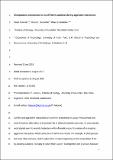Chimpanzees communicate to two different audiences during aggressive interactions
Abstract
Conflict and aggressive interactions are common phenomena in group-living animals and vocal behaviour often plays an important role in determining their outcomes. In some species, vocal signals seem to provide bystanders with information about the nature of an ongoing aggressive interaction, which can be beneficial for the victims. For example, in chimpanzees and some other primates, victims adjust their screams depending on the composition of the by-standing audience, probably to solicit their support. Considerably less is known, however, about the role of other call types produced by victims of aggression. In this study, we focused on the fact that, immediately after screams, chimpanzee, Pan troglodytes schweinfurthii, victims often produce 'waa' barks, but little is known about their function. Our results showed that for screams, but not 'waa' barks, production was dependent on the audience composition with victims being more likely to scream when adult or late-adolescent males were in close proximity. We also found that after 'waa' barking, but not screaming, victims were more likely to retaliate against and less likely to reconcile with their aggressors, and that 'waa' barking was more common after victims had received support from other party members. These results suggest that, in chimpanzees, victims of aggression vocalize with a dual social strategy of attempting to recruit support from bystanders and to repel their attackers by signalling readiness to retaliate. We conclude that victim scream and 'waa' bark calls, although often produced during the same agonistic event, are directed at different audiences and fulfil different social functions, and that these calls can mediate both aggressive interactions and aggressor-victim relationships following aggression.
Citation
Fedurek , P , Slocombe , K E & Zuberbuehler , K 2015 , ' Chimpanzees communicate to two different audiences during aggressive interactions ' , Animal Behaviour , vol. 110 , pp. 21-28 . https://doi.org/10.1016/j.anbehav.2015.09.010
Publication
Animal Behaviour
Status
Peer reviewed
ISSN
0003-3472Type
Journal article
Description
P.F. was funded by Swiss National Science Foundation (310030_143359) and European Research Council project grants to K.Z. (PRILANG 283871).Collections
Items in the St Andrews Research Repository are protected by copyright, with all rights reserved, unless otherwise indicated.

